
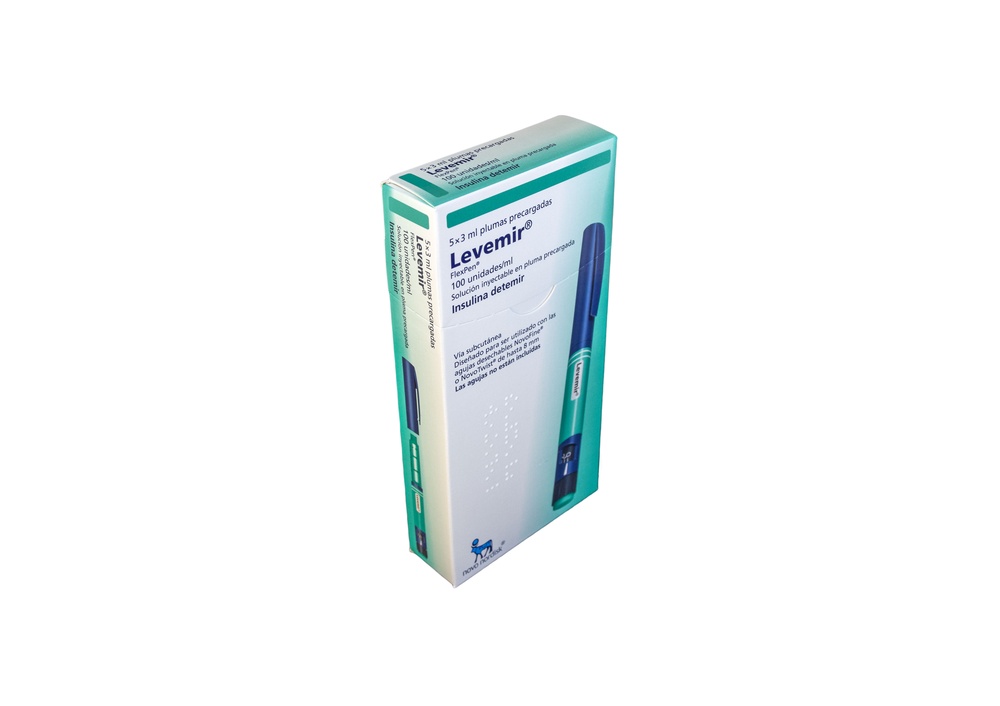
ЛЕВЕМІР ФЛЕКСПЕН 100 ОД/МЛ розчин для ін'єкцій у попередньо заповненому шприц-ручці

Запитайте лікаря про рецепт на ЛЕВЕМІР ФЛЕКСПЕН 100 ОД/МЛ розчин для ін'єкцій у попередньо заповненому шприц-ручці

Інструкція із застосування ЛЕВЕМІР ФЛЕКСПЕН 100 ОД/МЛ розчин для ін'єкцій у попередньо заповненому шприц-ручці
Введення
Опис препарату: інформація для користувача
Левемір 100одиниць/мл розчин для ін'єкцій у попередньо заповненому ін'єкційному пристрої
детемір інсуліну
Прочитайте уважно весь опис перед тим, як почати використовувати цей препарат, оскільки він містить важливу інформацію для вас.
- Збережіть цей опис, оскільки вам може знадобитися знову його прочитати.
- Якщо у вас є якісь питання, проконсультуйтеся з вашим лікарем, медсестрою або фармацевтом.
- Цей препарат призначений тільки для вас, і не слід давати його іншим людям, навіть якщо вони мають相同ні симптоми, оскільки це може їм нашкодити.
- Якщо ви відчуваєте побічні ефекти, проконсультуйтеся з вашим лікарем, медсестрою або фармацевтом, навіть якщо це побічні ефекти, які не наведені в цьому описі. Див. розділ 4.
Зміст опису
- Що таке Левемір і для чого він використовується
- Що вам потрібно знати перед тим, як почати використовувати Левемір
- Як використовувати Левемір
- Можливі побічні ефекти
- Збереження Левеміру
- Зміст упаковки та додаткова інформація
1. Що таке Левемір і для чого він використовується
Левемір - це сучасна інсулінова препарат (аналог інсуліну) тривалої дії. Сучасні інсуліни - це покращені версії людської інсуліну.
Левемір використовується для зниження високих рівнів цукру в крові у дорослих, підлітків і дітей віком від 1 року і старше з цукровим діабетом. Цукровий діабет - це захворювання, при якому організм не виробляє достатньої кількості інсуліну для контролю рівня цукру в крові.
Левемір можна використовувати разом з інсулінами швидкої дії, які вводяться в зв'язку з прийомом їжі.
При лікуванні цукрового діабету 2-го типу Левемір також можна використовувати в поєднанні з таблетками для лікування цукрового діабету і/або з ін'єкційними антидіабетичними препаратами, які не є інсуліном.
Левемір має тривалу і стабільну дію щодо зниження рівня цукру в крові протягом 3-4 годин після ін'єкції. Левемір забезпечує базове забезпечення інсуліном протягом до 24 годин.
2. Що вам потрібно знати перед тим, як почати використовувати Левемір
Не використовуйте Левемір
Якщо ви алергічні на детемір інсуліну або на будь-який інший компонент цього препарату, див. розділ 6, Зміст упаковки та додаткова інформація.
Якщо ви підозрюєте, що у вас може розвинутися гіпоглікемія (низький рівень цукру в крові), див. розділ 4, Можливі побічні ефекти.
Якщо ви використовуєте інсулінові помпи.
- Якщо FlexPen був пошкоджений або розбитий.
- Якщо він не був збережений правильно або був заморожений, див. розділ 5, Збереження Левеміру.
- Якщо інсулін не має прозорого, безбарвного і водянистого вигляду.
Якщо будь-яка з цих обставин стосується вас, не використовуйте Левемір. Проконсультуйтеся з вашим лікарем, медсестрою або фармацевтом.
Перед тим, як використовувати Левемір
- Перевірте маркування і переконайтесь, що інсулін такого типу був призначений вам.
- Всегда використовуйте нову голку для кожної ін'єкції, щоб уникнути забруднення.
- Голки і Левемір FlexPen не повинні бути спільними.
- Левемір FlexPen призначений тільки для ін'єкцій під шкіру. Проконсультуйтеся з вашим лікарем, якщо вам потрібно вводити інсулін іншим способом.
Попередження та застереження
Деякі захворювання та діяльності можуть вплинути на вашу потребу в інсуліні. Проконсультуйтеся з вашим лікарем:
Якщо у вас є захворювання нирок, печінки, надниркових залоз, гіпофізу або щитоподібної залози.
Якщо ви робите більше фізичних вправ, ніж зазвичай, або якщо ви хочете змінити свою дієту, оскільки це може вплинути на рівень цукру в вашій крові.
Якщо ви хворі, продовжуйте лікування інсуліном і проконсультуйтеся з вашим лікарем.
Якщо ви плануєте поїхати за кордон, різниця в часових зонах між країнами може вплинути на вашу потребу в інсуліні та час введення.
Якщо ваш рівень альбуміну дуже низький, контролюйте свій рівень цукру в крові дуже уважно. Поговоріть про це з вашим лікарем.
Зміни шкіри в місці ін'єкції
Слід змінювати місце ін'єкції, щоб уникнути змін у жировій тканині, таких як потовщення шкіри, її звуження або утворення підшкірних вузлів. Інсулін може не працювати дуже добре, якщо його вводити в місце з такими змінами (див. розділ 3, Як використовувати Левемір). Повідомте вашому лікареві, якщо ви виявите будь-які зміни в місці ін'єкції. Повідомте вашому лікареві, якщо ви зараз вводите інсулін в цих місцях, перед тим, як почати вводити його в інше місце. Ваш лікар може порадити вам контролювати рівень цукру в крові більш уважно та коригувати інсулін або дозу інших антидіабетичних препаратів.
Діти та підлітки
Левемір можна використовувати у підлітків і дітей віком від 1 року і старше.
Безпека та ефективність Левеміру у дітей молодше 1 року не встановлені.
Відсутні дані.
Інші препарати та Левемір
Повідомте вашому лікареві, медсестрі або фармацевту, якщо ви використовуєте, нещодавно використовували або можете використовувати будь-які інші препарати.
Деякі препарати можуть вплинути на рівень цукру в вашій крові, і це може означати, що ваша доза інсуліну повинна бути змінена. Нижче наведені основні препарати, які можуть вплинути на ваше лікування інсуліном.
Ваш рівень цукру в крові може знизитися (гіпоглікемія), якщо ви приймаєте:
- Інші препарати для лікування цукрового діабету
- Інгібітори моноамінооксидази (МАО) (використовуються для лікування депресії)
- Бета-блокатори (використовуються для лікування підвищеного артеріального тиску)
- Інгібітори ангіотензинперетворюючого ферменту (АПФ) (використовуються для лікування певних захворювань серця або підвищеного артеріального тиску)
- Саліцилати (використовуються для полегшення болю та зниження температури)
- Анаболічні стероїди (наприклад, тестостерон)
- Сульфонаміди (використовуються для лікування інфекцій).
Ваш рівень цукру в крові може підвищитися (гіперглікемія), якщо ви приймаєте:
- Оральні контрацептиви (таблетки для контрацепції)
- Тіазиди (використовуються для лікування підвищеного артеріального тиску або надмірної ретенції рідини)
- Глюкокортикоїди (наприклад, "кортизон" використовується для лікування запалення)
- Гормони щитоподібної залози (використовуються для лікування захворювань щитоподібної залози)
- Симпатикоміметики (наприклад, адреналін або салбутамол або тербуталін для лікування астми)
- Гормон росту (препарат для стимуляції соматичного та скелетного росту, який впливає на метаболічні процеси)
- Даназол (препарат, який впливає на овуляцію).
Октреотид та ланреотид (використовуються для лікування акромегалії, рідкого гормонального захворювання, яке зазвичай відбувається у дорослих середнього віку, викликаного надмірною продукцією гормону росту гіпофізом) можуть підвищувати або знижувати ваш рівень цукру в крові.
Бета-блокатори (використовуються для лікування підвищеного артеріального тиску) можуть послаблювати або повністю придушувати перші симптоми попередження, які можуть допомогти вам визначити, коли у вас низький рівень цукру в крові.
Піоглітазон (таблетки для лікування цукрового діабету 2-го типу)
Деякі пацієнти з цукровим діабетом 2-го типу тривалої дії та попереднім захворюванням серця або інсультом, які були behandлені піоглітазоном та інсуліном, розвинули серцеву недостатність. Повідомте вашому лікареві якнайшвидше, якщо ви маєте ознаки серцевої недостатності, такі як незвичайна відсутність повітря, швидке збільшення ваги або локалізована набряклість (едем).
Якщо ви приймали будь-які з цих препаратів, повідомте вашому лікареві, медсестрі або фармацевту.
Напої, що містять алкоголь, та використання Левеміру
Якщо ви споживаєте алкоголь, це може змінити вашу потребу в інсуліні, оскільки ваш рівень цукру в крові може підвищитися або знизитися. Рекомендується здійснювати уважний контроль.
Вагітність та лактація
Якщо ви вагітні, вважаєте, що можете бути вагітні або плануєте вагітність, проконсультуйтеся з вашим лікарем перед тим, як використовувати цей препарат. Можливо, буде потрібно змінити дозу інсуліну під час вагітності та після пологів. Для здоров'я вашої дитини важливо здійснювати уважний контроль над цукровим діабетом, особливо попередження гіпоглікемій.
Якщо ви перебуваєте в періоді лактації, проконсультуйтеся з вашим лікарем, оскільки можливо, буде потрібно змінити дозу інсуліну.
Проконсультуйтеся з вашим лікарем, медсестрою або фармацевтом перед тим, як використовувати будь-який препарат під час вагітності або лактації.
Водіння транспортних засобів та використання машин
Проконсультуйтеся з вашим лікарем, чи можете ви водити транспортний засіб або використовувати машини:
- Якщо ви часто маєте гіпоглікемію.
- Якщо вам важко визначити гіпоглікемію.
Якщо ваш рівень цукру в крові низький або високий, це може вплинути на вашу концентрацію та реакцію, а також на вашу здатність водити транспортний засіб або використовувати машини. Будьте обережні, оскільки це може становити загрозу для вашого життя або життя інших людей.
Важлива інформація про деякі компоненти Левеміру
Левемір містить менше 1 ммоль натрію (23 мг) на дозу; це означає, що він практично не містить натрію.
3. Як використовувати Левемір
Дозування та час введення інсуліну
Всегда використовуйте інсулін та коригуйте дозу саме так, як порадив ваш лікар. Якщо у вас є сумніви, проконсультуйтеся з вашим лікарем, медсестрою або фармацевтом.
Левемір можна використовувати разом з інсулінами швидкої дії, які вводяться в зв'язку з прийомом їжі.
При лікуванні цукрового діабету 2-го типу Левемір також можна використовувати в поєднанні з таблетками для лікування цукрового діабету і/або з ін'єкційними антидіабетичними препаратами, які не є інсуліном.
Не змінюйте інсулін, якщо ваш лікар не порадив вам цього.
Можливо, ваш лікар буде потрібно коригувати дозу, якщо:
- ваш лікар змінює тип або марку інсуліну на інший, або
- ваш лікар призначає вам інший препарат для лікування цукрового діабету, крім Левеміру.
Використання у дітей та підлітків
Левемір можна використовувати у підлітків і дітей віком від 1 року і старше.
Відсутні дані про використання Левеміру у дітей молодше 1 року.
Використання у спеціальних групах пацієнтів
Якщо у вас є порушення функції нирок або печінки (ниркова або печінкова недостатність), або якщо вам більше 65 років, вам потрібно контролювати рівень цукру в крові більш часто та проконсультуватися з вашим лікарем щодо зміни дози інсуліну.
Як часто вводити інсулін
Коли Левемір використовується в поєднанні з таблетками для лікування цукрового діабету і/або з ін'єкційними антидіабетичними препаратами, які не є інсуліном, його слід вводити один раз на добу. Коли Левемір використовується як частина режиму боло-базального, його слід вводити один або два рази на добу, залежно від потреб пацієнта. Дозу Левеміру потрібно коригувати індивідуально. Ін'єкцію можна проводити в будь-який час доби, але о同じ час кожного дня. У пацієнтів, які потребують двох доз на добу для оптимізації контролю рівня цукру в крові, дозу ввечері можна вводити ввечері або перед сном.
Як та де вводити інсулін
Левемір вводиться під шкіру (підшкірна ін'єкція). Ніколи не вводіть Левемір прямо в вену (внутрішньовенна ін'єкція) або м'яз (внутрішньом'язова ін'єкція). Левемір FlexPen призначений тільки для ін'єкцій під шкіру. Проконсультуйтеся з вашим лікарем, якщо вам потрібно вводити інсулін іншим способом.
При кожній ін'єкції змінюйте місце ін'єкції всередині певної ділянки шкіри, яку ви зазвичай використовуєте. Це може зменшити ризик розвитку потовщення або звуження шкіри (див. розділ 4, Можливі побічні ефекти). Найкращі ділянки для ін'єкції - це передня частина стегна, ділянка живота та зовнішня частина верхньої частини руки. Регулярно контролюйте рівень цукру в крові.
Як обробляти Левемір FlexPen
Левемір FlexPen - це попередньо заповнений, одноразовий ін'єкційний пристрій з кольоровим кодом, який містить детемір інсуліну.
Уважно прочитайте інструкції з використання, які додані до цього опису. Ви повинні використовувати пристрій саме так, як описано в інструкції з використання.
Всегда переконуйтесь, що ви використовуєте правильний пристрій перед тим, як вводити інсулін.
Якщо ви використали більше інсуліну, ніж потрібно
Якщо ви використали надмірну кількість інсуліну, ваш рівень цукру в крові може стати дуже низьким (гіпоглікемія). Див. розділ 4, Можливі побічні ефекти.
Якщо ви забули використати інсулін
Якщо ви забули ввести інсулін, ваш рівень цукру в крові може стати дуже високим (гіперглікемія). Див. розділ 4, Можливі побічні ефекти.
Якщо ви припинили лікування інсуліном
Не припиняйте лікування інсуліном без консультації з вашим лікарем, оскільки це може призвести до високого рівня цукру в крові (гіперглікемія) та кетоацидозу. Див. розділ 4, Можливі побічні ефекти.
Якщо у вас є будь-які інші питання щодо використання цього препарату, проконсультуйтеся з вашим лікарем або фармацевтом.
4. Можливі побічні ефекти
Як і всі лікарські засоби, цей лікарський засіб може викликати побічні ефекти, хоча не всі люди їх відчувають.
- Перегляд серйозних і дуже частих побічних ефектів
Низький рівень цукру в крові (гіпоглікемія)є дуже частим побічним ефектом. Він може вплинути на більше ніж 1 з 10 людей.
Низький рівень цукру в крові може виникнути, якщо:
- Введено надто багато інсуліну.
- Ви їсте дуже мало або пропускаєте прийом їжі.
- Ви робите більше фізичних вправ, ніж зазвичай.
- Ви вживаєте алкоголь (див. розділ 2, Алкогольні напої та використання Левеміру).
Симптоми попередження низького рівня цукру в крові: холодний пот, холодна і бліда шкіра, головний біль, серцебиття, нудота, надмірний апетит, тимчасові зміни зору, сонливість, втома і незвичайна слабкість, нервозність або тремор, тривога, замішання і труднощі з концентрацією.
Серйозне зниження рівня цукру в крові може призвести до втрати свідомості. Якщо серйозне і тривале зниження рівня цукру в крові не лікується, воно може викликати пошкодження мозку (тимчасове або постійне) і навіть смерть. Ви можете швидше відновити свідомість, якщо вам введуть ін'єкцію глюкагону людина, яка знає, як це зробити. Якщо вам введуть глюкагон, вам потрібно прийняти глюкозу або цукрозмістний продукт якнайшвидше після відновлення свідомості. Якщо ви не реагуєте на лікування глюкагоном, вам потрібно лікувати в лікарні.
Що робити, якщо ваш рівень цукру в крові низький:
? Якщо ваш рівень цукру в крові низький, прийміть таблетки глюкози або цукрозмістний продукт (цукерки, печиво, фруктовий сік). Виміряйте свій рівень цукру в крові, якщо це можливо, а потім відпочиньте. Завжди носіть з собою таблетки глюкози або продукти, що містять цукор, на випадок, якщо вам потрібно буде їх використовувати.
? Коли симптоми гіпоглікемії зникнуть або коли рівень цукру в крові стабілізується, продовжуйте лікування інсуліном, як зазвичай.
? Якщо у вас були рівні цукру в крові настільки низькі, що вони викликали втрату свідомості, якщо вам потрібно було введення ін'єкції глюкагону, або якщо у вас були численні зниження рівня цукру в крові, поговоріть з вашим лікарем. Можливо, вам потрібно буде коригувати кількість або схему введення інсуліну, харчування або фізичних вправ.
Повідомте інших про те, що у вас цукровий діабет, і про можливі наслідки, включаючи ризик втрати свідомості через зниження рівня цукру в крові. Повідомте їх про те, що якщо ви втрачите свідомість, їм потрібно буде покласти вас на бік і негайно шукати медичну допомогу. Їм не потрібно давати вам нічого їсти чи пити, оскільки ви можете задихнутися.
Серйозна алергічна реакціяна Левемір або на один з його компонентів (алергічна реакція системи) є дуже рідкісним, але потенційно смертельним побічним ефектом. Він може вплинути на до 1 з 10 000 людей.
Негайно зверніться до лікаря:
- Якщо ознаки алергії поширюються на інші частини вашого тіла.
- Якщо ви раптом відчуваєте себе хворим і маєте пот, блювоту, труднощі з диханням, серцебиття, відчуваєте себе головокружим.
? Якщо ви помітите будь-які з цих симптомів, негайно зверніться до лікаря.
Зміни шкіри в місці ін'єкції: Якщо ви вводите інсулін в одному і тому ж місці, жирова тканина може зменшиться (ліпоатрофія) або збільшитися (ліпогіпертрофія) (це може вплинути на до 1 з 100 людей). Підшкірні вузлики також можуть виникнути через накопичення білка, званого амілоїдом (кутанна амілоїдоз; невідомо, з якою частотою це відбувається). Інсулін може не працювати дуже добре, якщо його вводити в набряклі, зменшені або збільшені ділянки шкіри. Змініть місце ін'єкції, щоб допомогти уникнути цих змін шкіри.
- Перелік інших побічних ефектів
Побічні ефекти, що рідко зустрічаються
Можуть вплинути на до 1 з 100 людей.
Ознаки алергії: Можуть виникнути місцеві алергічні реакції в місці ін'єкції (біль, червоність, висип, запалення, синяки, набряк і свербіж). Ці реакції зазвичай зникають після кількох тижнів лікування. Якщо симптоми не зникають, або якщо вони поширюються по вашому тілу, негайно зверніться до лікаря. Див. також Серйозна алергічна реакція вище.
Проблеми з зором: При початку лікування інсуліном ви можете мати проблеми з зором, але ця порушення зазвичай тимчасова.
Набряк суглобів: При початку лікування інсуліном накопичення рідини може викликати запалення щиколоток і інших суглобів. Цей ефект зазвичай швидко зникає. Якщо ні, зверніться до лікаря.
Діабетична ретинопатія (захворювання очей, пов'язане з цукровим діабетом, яке може призвести до втрати зору): Якщо у вас діабетична ретинопатія і ваш рівень цукру в крові покращується дуже швидко, ретинопатія може погіршитися. Зверніться до лікаря.
Побічні ефекти, що дуже рідко зустрічаються
Можуть вплинути на до 1 з 1000 людей.
Больовий нейропатичний синдром (біль через пошкодження нерва): якщо ваш рівень цукру в крові покращується дуже швидко, ви можете відчувати біль, пов'язаний з нервом, це називається гострим болевим нейропатичним синдромом і зазвичай тимчасовий.
Звіт про побічні ефекти
Якщо ви відчуваєте будь-який побічний ефект, зверніться до лікаря, фармацевта або медсестри, навіть якщо це можливі побічні ефекти, які не перелічені в цьому листку. Ви також можете повідомити про них безпосередньо через Систему моніторингу лікарських засобів для людини: www.notificaRAM.es. Надсилаючи повідомлення про побічні ефекти, ви можете допомогти надати більше інформації про безпеку цього лікарського засобу.
- Ефекти діабету
Високий рівень цукру в крові (гіперглікемія)
Можуть виникнути високі рівні цукру в крові, якщо:
- Не введено достатньо інсуліну.
- Якщо ви забули ввести інсулін або перервали лікування інсуліном.
- Якщо ви повторно вводите менше інсуліну, ніж вам потрібно.
- Якщо у вас є інфекція або гарячка.
- Якщо ви їсте більше, ніж зазвичай.
- Якщо ви робите менше фізичних вправ, ніж зазвичай.
Симптоми попередження високого рівня цукру в крові:
Симптоми попередження з'являються поступово. Вони включають: збільшення потреби в сечовипусканні, спрагу, втрату апетиту, відчуття нудоти (або блювоту), сонливість або втома, суху і червону шкіру, відчуття сухості в роті та запах ацетону в диханні.
Що робити, якщо ваш рівень цукру в крові дуже високий:
? Якщо ви помітите будь-які з цих симптомів: контролюйте свій рівень цукру в крові, контролюйте рівень кетонів у сечі, якщо це можливо, і негайно зверніться до лікаря.
? Це можуть бути симптоми дуже серйозного захворювання, яке називається діабетична кетоацидоз (накопичення кислоти в крові через те, що організм розщеплює жир замість цукру). Якщо це не лікується, воно може призвести до діабетичної коми та смерті.
5. Зберігання Левеміру
Тримайте цей лікарський засіб поза зоною досяжності дітей.
Не використовувати цей лікарський засіб після закінчення терміну придатності, вказаного на етикетці FlexPen і на упаковці після CAD. Термін придатності - останній день місяця, який вказано.
Завжди тримайте кришку на FlexPen, коли не використовуєте його, щоб захистити його від світла.
Левемір повинен бути захищений від високої температури та світла.
До відкриття:FlexPen Левеміру, який не використовується, повинен зберігатися в холодильнику при температурі між 2°C і 8°C, далеко від охолоджувального елемента. Не заморожувати.
Під час використання або коли використовується як запас:Ви можете носити з собою FlexPen Левеміру і зберігати його при температурі нижче 30°C або в холодильнику (між 2°C і 8°C) протягом 6 тижнів. Якщо ви зберігатимете його в холодильнику, тримайте його далеко від охолоджувального елемента. Не заморожувати.
Лікарські засоби не повинні викидатися в каналізацію чи сміттєві контейнери. Спитайте у вашого фармацевта, як позбутися упаковок та лікарських засобів, які вам більше не потрібні. Таким чином, ви допоможете захистити навколишнє середовище.
6. Зміст упаковки та додаткова інформація
Склад Левеміру
- Активний інгредієнт - інсулін детемір. Кожен мл містить 100 одиниць інсуліну детеміру. Кожна попередньо наповнена ручка містить 300 одиниць інсуліну детеміру в 3 мл розчину для ін'єкцій. 1 одиниця інсуліну детеміру відповідає 1 міжнародній одиниці людського інсуліну.
- Інші компоненти - гліцерол, фенол, метакрезол, ацетат цинку, дигідрат дифосфату натрію, хлорид натрію, хлоридна кислота, гідроксид натрію та вода для ін'єкцій.
Вигляд продукту та вміст упаковки
Левемір представлений у вигляді розчину для ін'єкцій.
Упаковки, які містять 1 (з або без голок), 5 (без голок) та 10 (без голок) попередньо наповнених ручок по 3 мл. Можливо, не всі ці варіанти упаковок будуть доступні.
Власник дозволу на продаж та відповідальний за виробництво
Власник дозволу на продаж
Novo Nordisk A/S, Novo Allé, DK-2880 Bagsværd, Данія
Відповідальний за виробництво
Відповідальний за виробництво можна ідентифікувати за номером партії, надрукованим на кришці картону та на етикетці:
- Якщо другий і третій символи - S6, P5, K7, R7, VG, FG або ZF, відповідальний за виробництво - Novo Nordisk A/S, Novo Allé, DK-2880 Bagsværd, Данія.
- Якщо другий і третій символи - H7 або T6, відповідальний за виробництво - Novo Nordisk Production SAS, 45 Avenue d´Orléans, F-28000 Chartres, Франція.
На зворотному боці наведені інструкції з використання FlexPen.
Дата останнього перегляду цього листка:
Інші джерела інформації
Детальна інформація про цей лікарський засіб доступна на сайті Європейського агентства з лікарських засобів: http://www.ema.europa.eu.
Інструкції з використання ЛЕВЕМІРу розчину для ін'єкцій у FlexPen
Вважно прочитайте наступні інструкції перед використанням вашого FlexPen.Якщо ви не будете слідувати інструкціям уважно, ви можете ввести собі занадто мало або занадто багато інсуліну, що може призвести до надто високого або надто низького рівня цукру в крові.
FlexPen - це попередньо наповнена ручка-ін'єктор інсуліну. Можна вибрати дози від 1 до 60 одиниць з кроком 1 одиниця. FlexPen призначений для використання з голками NovoFine або NovoTwist довжиною до 8 мм. Як заходи обережності, завжди носіть з собою запасний ін'єктор інсуліну на випадок, якщо FlexPen, який ви використовуєте, загубиться або пошкодиться.

Перед використання
Перед використанням FlexPen зверніться до лікаря або медсестри для отримання інформації про правильне використання.
Обробка ручки
Ви повинні оберігати свій FlexPen.
Якщо він впаде, пошкодиться або вдариться, існує ризик того, що інсулін виходить. Це може призвести до неправильної дозування, що може призвести до надто високого або надто низького рівня цукру в крові.
Ви можете очистити зовнішню частину FlexPen ватним тампоном, змоченим у спирті. Не занурюйте його у воду, не миjte та не змащуйте, оскільки ручка може пошкодитися.
Не перезаряджайте свій FlexPen.
Підготовка Левемір FlexPen
Перевірте ім'я та кольорову етикетку вашої ручки, щоб переконатися, що вона містить правильний тип інсуліну. Це особливо важливо, якщо ви використовуєте кілька типів інсуліну. Якщо ви використовуєте неправильний тип інсуліну, ваш рівень цукру в крові може стати надто високим або надто низьким.
А
Зніміть кришку з ручки.

Б
Зніміть паперову стрічку з нової голки.
Навініть голку прямо та міцно на FlexPen.

В
Зніміть зовнішню кришку голки та збережіть її для подальшого використання.

Г
Зніміть внутрішню кришку голки та викиньте її.
Ніколи не намагайтесь знову надіти внутрішню кришку голки. Ви можете поранитися голкою.

Використовуйте завжди нову голку для кожної ін'єкції. Це зменшує ризик зараження, інфекції, втрати інсуліну, забивання голок та неправильної дозування.
Будьте обережні, щоб не згинати або пошкоджувати голку перед використанням.
Перевірка потоку інсуліну
Перед кожною ін'єкцією можуть виникнути маленькі кількості повітря в картриджі під час нормального використання. Щоб уникнути ін'єкції повітря та забезпечити правильне дозування:
Д
Поверніть селектор дози, щоб вибрати 2 одиниці.
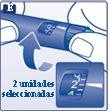
Є
Утримуйте FlexPen з голкою, спрямованою вгору, та стукайте картридж пальцем кілька разів, щоб зробити бульбашки повітря осісти на верхній частині картриджа.

Ж
Тримайте голку вгору, натисніть кнопку до кінця, поки селектор дози не повернеться до 0.
Краплина інсуліну повинна з'явитися на кінчику голки. Якщо ні, замініть голку та повторіть процедуру до максимуму 6 разів.
Якщо краплина інсуліну все ще не з'являється, ручка є дефектною, та ви повинні використовувати нову.
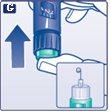
Усієїди переконайтеся, що краплина з'являється на кінчику голки перед ін'єкцією. Це забезпечує те, що інсулін тече. Якщо краплина не з'являється, інсулін не буде введений, хоча селектор дози рухатиметься. Це може вказувати на те, що голка заблокована або пошкоджена.
Завжди перевіряйте потік перед ін'єкцією. Якщо ви не перевіряєте потік, ви можете отримати недостатню кількість інсуліну або навіть жодної. Це може призвести до надто високого рівня цукру в крові.
Вибір дози
Перевірте, що селектор дози вказує на 0.
З
Поверніть селектор дози, щоб вибрати кількість одиниць, яку ви хочете ввести.
Дозу можна коригувати вперед та назад, повертаючи селектор дози в будь-якому напрямку, поки коригована доза не буде вишикована з маркером дози. Коли ви повертаєте селектор дози, будьте обережні, щоб не натиснути кнопку, оскільки інсулін може вийти.
Ви не можете вибрати дозу, яка більша за кількість одиниць, які залишилися в картриджі.
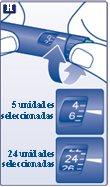
Перед ін'єкцією інсуліну завжди використовуйте селектор дози та маркер дози, щоб побачити, скільки одиниць ви вибрано.
Не рахуйте кліки ручки. Якщо ви вибрано неправильну дозу та ввели її, ваш рівень цукру в крові може стати надто високим або надто низьким. Не використовуйте шкалу залишку інсуліну, оскільки вона показує лише приблизну кількість інсуліну, яка залишилася в ручці.
Ін'єкція
Вставте голку під шкіру. Використовуйте техніку ін'єкції, вказану вашим лікарем або медсестрою.
І
Введіть дозу, натиснувши кнопку до кінця, поки 0 не буде вишиковано з маркером дози. Будьте обережні, щоб натиснути кнопку лише під час ін'єкції.
Повертаючи селектор дози, ви не введете інсулін.

Ї
Тримайте кнопку повністю натиснутою та тримайте голку під шкірою протягом щонайменше 6 секунд. Це забезпечить те, що повна доза буде введена.
Видаліть голку зі шкіри та, як тільки ви це зробите, припиніть натискати кнопку.
Усієїди переконайтеся, що селектор дози повертається до 0 після ін'єкції. Якщо селектор дози зупиняється перед досягненням 0, повна доза не була введена, що може призвести до надто високого рівня цукру в крові.
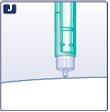
Й
Накрийте голку зовнішньою кришкою, не торкаючись її. Коли голка буде накрита, натисніть зовнішню кришку обережно повністю, а потім відверніть голку.
Викиньте її обережно та знову накрийте ручку кришкою.

Завжди видаляйте голку після кожної ін'єкції та зберігайте FlexPen без голки. Це зменшує ризик зараження, інфекції, втрати інсуліну, забивання голок та неправильної дозування.
Інша важлива інформація
Люди, які доглядають за цими пацієнтами, повинні бути дуже обережними при роботі з використаними голками, щоб зменшити ризик випадкових уколів та інфекцій.
Викиньте свій використаний FlexPen обережно без голки.
Ніколи не діліться ручкою чи голками з іншими людьми. Це може призвести до інфекцій.
Ніколи не діліться ручкою з іншими людьми. Ваш лікарський засіб може бути шкідливим для здоров'я цих людей.
Завжди тримайте ручку та голки поза зоною досяжності інших людей, особливо дітей.

Скільки коштує ЛЕВЕМІР ФЛЕКСПЕН 100 ОД/МЛ розчин для ін'єкцій у попередньо заповненому шприц-ручці в Іспанії у 2025 році?
ЛЕВЕМІР ФЛЕКСПЕН 100 ОД/МЛ розчин для ін'єкцій у попередньо заповненому шприц-ручці коштує в середньому 78.52 євро у листопад, 2025 році. Ціна може змінюватися залежно від регіону, аптеки та наявності рецепта. Рекомендуємо перевіряти актуальну вартість у місцевих аптеках або через онлайн-сервіси.
- Країна реєстрації
- Середня ціна в аптеках78.52 EUR
- Діючі речовини
- Потрібен рецептТак
- Виробник
- Інформація є довідковою і не є медичною порадою. Перед прийомом будь-яких препаратів обов'язково проконсультуйтеся з лікарем. Oladoctor не несе відповідальності за медичні рішення, прийняті на основі цього контенту.
- Альтернативи до ЛЕВЕМІР ФЛЕКСПЕН 100 ОД/МЛ розчин для ін'єкцій у попередньо заповненому шприц-ручціФорма випуску: РОЗЧИН ДЛЯ ІН'ЄКЦІЙ, 100 ОД/млДіючі речовини: insulin detemirВиробник: Novo Nordisk A/SПотрібен рецептФорма випуску: РОЗЧИН ДЛЯ ІН'ЄКЦІЙ, 100 ОД/млДіючі речовини: insulin glargineВиробник: Eli Lilly Nederland B.V.Потрібен рецептФорма випуску: РОЗЧИН ДЛЯ ІН'ЄКЦІЙ, НевідомоДіючі речовини: insulin glargineВиробник: Sanofi-Aventis Deutschland GmbhПотрібен рецепт
Аналоги ЛЕВЕМІР ФЛЕКСПЕН 100 ОД/МЛ розчин для ін'єкцій у попередньо заповненому шприц-ручці в інших країнах
Найкращі аналоги з тією самою діючою речовиною та терапевтичним ефектом.
Аналог ЛЕВЕМІР ФЛЕКСПЕН 100 ОД/МЛ розчин для ін'єкцій у попередньо заповненому шприц-ручці у Україна
Лікарі онлайн щодо ЛЕВЕМІР ФЛЕКСПЕН 100 ОД/МЛ розчин для ін'єкцій у попередньо заповненому шприц-ручці
Консультація щодо дозування, побічних ефектів, взаємодій, протипоказань та поновлення рецепта на ЛЕВЕМІР ФЛЕКСПЕН 100 ОД/МЛ розчин для ін'єкцій у попередньо заповненому шприц-ручці – за рішенням лікаря та згідно з місцевими правилами.














